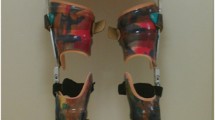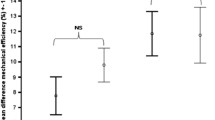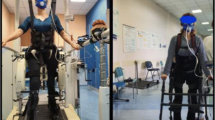Abstract
The energy cost of walking using a reciprocating gait orthosis (RGOII) with functional electrical stimulation (FES) was assessed in 14 patients with spastic complete paraplegia from six rehabilitation centres. Before and after training asing RGOII with FES, the subjects performed a progressive maximal test on an arm-crank ergometer to obtain their laboratory peak oxygen uptake\((L\dot VO_{2peak} )\) heart rate (HR) and blood lactate concentration changes. At the end of the training session, oxygen uptake\((\dot VO_2 )\) was measured during a walking test with orthosis at different speeds (6 min steady state at 0.1 m · s−1, followed by 2-min stages at progressively increasing speeds up to exhaustion). Of the subjects 4 repeated this test using orthosis without FES. At a speed of 0.1 m · s−1,\(\dot VO_2 \) represented 47 (SD 23)% of\(L\dot VO_{2peak} \), mean HR was 137 (SD 21) beats · min−1 and mean blood lactate concentration 2.4 (SD 1.4) mmol · l−1. Maximal speed ranged from 0.23 to 0.5 m · s−1. At maximal speed,\(\dot VO_2 \) was 91 (SD 18) % of\(L\dot VO_{2peak} \) mean HR reached 96 (SD 7)% and mean blood lactate concentration only 52 (SD 19)% of the maximal values measured during the laboratory test. Walking without electrical stimulation induced an increase in HR but there was no difference in\(\dot VO_2 \) and blood lactate compared to walking with stimulation. The training period did not result in any improvement in maximal physiological data. We concluded that the free cadence walking speed with orthosis remains much lower than that of able-bodied people or wheelchair users. The metabolic cost at a given speed is much higher even if, using a stimulation device, the cardiovascular stress is reduced.
Similar content being viewed by others
References
Bergh U, Kanstrup IL, Ekblom B (1976) Maximal oxygen uptake during exercise with various combinations of arm and leg work. J Appl Physiol 41:191–196
Bessou P, Dupui P, Montoya R, Pages B (1988) Simultaneous recording of longitudinal displacements of both feet during human walking. J Physiol (Paris) 83:102–110
Billat V, Palleja P, Charlaix T, Rizzardo P, Janel N (1995) Energy specificity of rock climbing and aerobic capacity in competitive sport rock climbers. J Sports Med Phys Fitness 35:20–24
Cerny K, Waters R, Hislop H, Perry J (1980) Walking and wheelchair energetics in persons with paraplegia. Phys Ther 60:1133–1139
Clinkingbeard JR, Gersten JW, Hoehn D (1964) Energy cost of ambulation in the traumatic paraplegias. Am J Phys Med 43:157–165
Cooney MM, Walker JB (1986) Hydraulic resistance exercise benefits cardiovascular fitness of spinal cord injured. Med Sci Sports Exerc 18:522–525
Davies GM, Servedio FJ, Glaser RM, Gupta SG, Suryaprasao AG (1990) Cardiovascular responses to arm-cranking and FNS-induced leg exercise in paraplegics. J Appl Physiol 69:671–677
Di Carlo SE, Supp MD, Taylor HC (1983) Effect of arm ergometry on physical work capacity of individuals with spinal cord injuries. Phys Ther 63:1104–1107
Flandrois R, Grandmontagne M, Guérin H, Mayet MH, Jehl JL, Eyssette M (1986) Aerobic performance capacity in paraplegic subjects. Eur J Appl Physiol 55:604–609
Glaser RM (1985) Exercise and locomotion for the spinal cord injured. Exerc Sports Sci Rev 13:263
Glaser RM (1989) Arm exercise training for wheelchair users. Med Sci Sports Exerc 21:5149–5157
Glaser RM, Simsen-Harold CA, Petrofsky JS, Kahn SE, Sury-Aprasad AG (1983) Metabolic and cardiopulmonary responses of older wheelchair-dependent and ambulatory patients during locomotion. Ergonomics 26:687–697
Hirokawa S, Grimm M, Thank L, Solomonow M, Baratta R, Shoji H, D'Ambrosia R (1990) Energy consumption in paraplegic ambulation using the reciprocating gait orthosis and electric stimulation of the thigh muscles. Arch Phys Med Rehabil 71:687–694
Hooker SP, Wells CL (1988) Effects of low-and moderate-intensity training in spinal cord-injured persons. Med Sci Sports Exerc 21:18–22
Huang CT, Kuhlemeier KV, Moore MB, File PR (1979) Energy cost of ambulation in paraplegic patients using craig scott braces. Arch Phys Med Rehabil 60:595–600
Isakov E, Douglas R, Berns P (1992) Ambulating using the reciprocating gait orthosis and functional electrical stimulation. Paraplegia 30:239–245
Janssen TWJ, Van Oers CAJM, Van der Woude LHV, Hollander AP (1994) Physical strain in daily life of wheelchair users with spinal cord injuries. Med Sci Sports Exerc 26:661–670
Jehl JL, Coudert J, Grandmontagne M, Boisson D, Eyssette M (1985) Mesure directe de la\(\dot VO_2 \) max chez le paraplégique sportif. A propos de 5 observations. Ann Réadapt Méd Phys 28:5–12
Kofsky PR, Davis GM, Jackson RW, Keene GCR, Shephard RJ (1983) Field testing assessment of physical fitness of disabled adults. Eur J Appl Physiol 51:109–120
Lotta S, Fiocchi A, Giouannini R, Silvestrin R, Tesio L et al (1994) Restoration of gait with orthoses in thoracic paraplegia: a multicentric investigation. Paraplegia 32:608–615
Marsolais EB, Bennett GE (1988) Energy costs of walking and standing with functional neuromuscular stimulation and long leg braces. Arch Phys Med Rehabil 69:243–249
Merkel KD, Miller NE, Merritt JL (1985) Energy expenditure in patients with low-, mid-, or high-thoracic paraplegia using Scott-Craig knee-ankle-foot orthoses. Mayo Clin Proc 60:165–166
Nene AV, Patrick JH (1990) Energy cost of paraplegic locomotion using the parawalker-electrical stimulation hybrid orthosis. Arch Phys Med Rehabil 71:116–120
Noreau L, Shephard RJ (1992) Physical, fitness and productive activity of paraplegics. Sports Med Training and Rehabil 3:165–181
Perry J (1992) Stride analysis In: Slack (eds) Gait analysis normal and pathological function. Thorofare NJ, p 52
Sawka MN, Catzka WA, Pandolf KB (1989) Temperature regulation during upper body exercise: able bodied and spinal cord injured. Med Sci Sports Exerc 21:S132-S140
Solomonow M, Baratta R, Hirokawa S, Rightor N, Walker W, Beaudette P, Shoji H, D'Ambrosia R (1989) The RGO generation II: Muscle stimulation powered orthosis as a practical walking system for thoracic paraplegics. Orthopedics 12:1309–1315
Whittle MW (1988) Paraplegic locomotion. Clin Rehabil 2:45–49
Whittle MW, Cochrane GM, Chase AP, Copping AV, Jefferson RJ, Staples DJ, Fenn PT, Thomas DC (1991) A comparative trial of two walking systems for paralysed people. Paraplegia 29:97–102
Winchester P, Carollo JJ, Habasevish R (1994) Physiologic costs of reciprocal gait in F.E.S assisted walking. Paraplegia 32:680–686
Author information
Authors and Affiliations
Rights and permissions
About this article
Cite this article
Beillot, J., Carré, F., Le Claire, G. et al. Energy consumption of paraplegic locomotion using reciprocating gait orthosis. Europ. J. Appl. Physiol. 73, 376–381 (1996). https://doi.org/10.1007/BF02425502
Accepted:
Issue Date:
DOI: https://doi.org/10.1007/BF02425502




